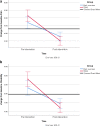Effects of back exercises versus transcutaneous electric nerve stimulation on relief of pain and disability in operating room nurses with chronic non-specific LBP: a randomized clinical trial
- PMID: 35337314
- PMCID: PMC8957119
- DOI: 10.1186/s12891-022-05227-7
Effects of back exercises versus transcutaneous electric nerve stimulation on relief of pain and disability in operating room nurses with chronic non-specific LBP: a randomized clinical trial
Abstract
Background: Low back pain (LBP) is one of the most common musculoskeletal disorders related to working. Due to the nature of nursing work, this problem is often seen in nurses, including those who work in the operating rooms. Depending on the cause, there are various surgical and non-surgical methods to treat LBP. The present study was aimed to compare the effect of two therapeutic methods of back exercises and transcutaneous electrical nerve stimulation (TENS) on the disability and pain of operating room nurses with LBP.
Methods: In this clinical trial forty-four eligible operating room nurses (30 women, 14 men, mean age: 37.86 ± 6.74) with chronic nonspecific LBP were randomly assigned to back exercises (including the strengthening and stretching exercise (n = 22)) or TENS (n = 22) groups by permuted block randomization method. These interventions were performed in both groups three sessions of 15 min per week for 6 weeks. The McGill pain questionnaire for back pain and the Oswestry disability questionnaire for disability assessment were completed immediately before and after the interventions.
Results: After 6 weeks, the mean of pain and disability decreased significantly in both groups compared to the baseline. Based on the results, significant decreases in the pain score (mean difference (95% CI): - 8.95 (- 12.77 to - 5.14); P-value < 0.001) and disability score (mean difference (95% CI): - 8.73(- 12.42 to - 5.03); P-value < 0.001) were revealed in the back exercises group after the intervention compared to the baseline. In addition, after the intervention in TENS group, the mean pain intensity and disability showed significant decrease, respectively (mean difference (95% CI): - 16.18 (- 19.81 to - 12.55); P-value < 0.001; mean difference (95% CI): - 15.82 (- 19.24 to - 12.40); P-value < 0.001). After adjusting for the baseline values, the TENS group had a significantly higher pain score reduction than the back exercises group (mean difference (95% CI): - 4.23 (- 8.03 to - 0.44); P-value =0.030; Cohen's d = 0.81). In addition, TENS led to a significant more decrease in the disability scores compared to the back exercises (mean difference (95% CI): - 3.99 (- 7.35 to - 0.64); P-value =0.021; Cohen's d = 0.73). Furthermore, a statistically significant time by group interaction effect on pain and disability score was found (interaction p < 0.001).
Conclusion: Pain and disability were improved in both groups following 18 intervention sessions. However, pain and disability were improved to a greater extent in the TENS group than in the back exercises group.
Trial registration: The trial was retrospectively registered in the Iranian Registry of Clinical Trials ( www.irct.ir ) on 03/02/2019 as IRCT20180408039227N1 .
Keywords: Exercise therapy; Low Back pain; Transcutaneous electric nerve stimulation.
© 2022. The Author(s).
Conflict of interest statement
The authors declare that they have no competing interests.
Figures
References
-
- Van Eerd D, Munhall C, Irvin E, Rempel D, Brewer S, Van Der Beek A, Dennerlein J, Tullar J, Skivington K, Pinion C. Effectiveness of workplace interventions in the prevention of upper extremity musculoskeletal disorders and symptoms: an update of the evidence. Occup Environ Med. 2016;73(1):62–70. doi: 10.1136/oemed-2015-102992. - DOI - PMC - PubMed
Publication types
MeSH terms
LinkOut - more resources
Full Text Sources
Miscellaneous




